After the wonderful spring cruise this year (2000) I had an
opportunity to sell my Dovekie, and I did. Why? I have enjoyed Dovekie
#119 for about 12 years (at least when I was living in DC), and have
enjoyed the invitations of John Zohlen, Phil Sampson and others when I
have crewed for them on their Dovekies. I like everything about the
Dovekie, but recently my knees are objecting to crawling forward.
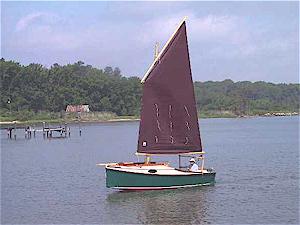 So... After
selling my Dovekie, I began searching for a replacement which would be
comparable with Shallow Water Sailing. I wanted a boat in which I could
walk from stern to bow without crawling, and secondarily, self rescuing.
(after my capsize on the 1988 Elk River Spring Cruise, I feel as if I have
not sailed as aggressively as I would like). I did not need a boat as big
as Dovekie for my single handing, and if it was under 20 feet, perhaps it
would fit in a garage with room to spare for working on it. So... After
selling my Dovekie, I began searching for a replacement which would be
comparable with Shallow Water Sailing. I wanted a boat in which I could
walk from stern to bow without crawling, and secondarily, self rescuing.
(after my capsize on the 1988 Elk River Spring Cruise, I feel as if I have
not sailed as aggressively as I would like). I did not need a boat as big
as Dovekie for my single handing, and if it was under 20 feet, perhaps it
would fit in a garage with room to spare for working on it.
I looked at Bolger's Camper, an 18 foot design based on his Birdwatcher. I
had seen (but not sailed) a Birdwatcher built by Jim Michalak, so I also
considered a few of Jim's designs. (found at
www.apci.net/~michalak/) I
also corresponded with a few people who had built Michalak designs, and
thought his
AF3 would almost suit. But at 15 feet long, I thought it could be a
little bit bigger. So I sent the following letter:
Jim Michalak
118 E. Randle St.
Lebanon IL 62254
re: AF “2.5"
Dear Jim,
Thanks for the fax concerning your terms for modifying AF2 and AF3 for
me. The arrangement you describe is fine with me. Therefore, I have
enclosed a check as payment in full for design of a sailboat similar to
your designs AF2 and AF3. I understand that the resulting plans and
instructions are for me to build one boat only, and that you will try to
sell copies of the plans to others.
To recap my design requirements: I previously owned and sailed a
Dovekie; this boat is to replace it with two major improvements: 1) no
crawling necessary and 2) self rescuing. I also want a boat slightly
shorter than the Dovekie so it will fit comfortably in a 20' garage.
- Boat and trailer 20' or less overall, so perhaps an 18' boat.
- Slot-top to allow walking upright from cockpit to bow.
- Enough flotation areas to allow self-rescuing.
- enough ballast for single-handing, but without water ballast.
- cabin length 6'4" or more, for sleeping.
- Two oar ports, port & starboard
- two offset stern sculling points so I can stand on the centerline
while sculling.
- provision for motor mount for small outboard. (your suggestion.)
- kick up rudder and lee board(s).
- stowage rack for oars while under sail; and for spars while rowing.
Perhaps a cradle on one side of the cabin top.
- Rig: I liked Dovekie's sprit rig; I have sailed gaff rigged Bay Hen
which has too many strings when striking the rig. I like the idea of
your standing lug, but I need windward ability to short tack on the
narrow estuaries of the Chesapeake. Can a sprit rig work?
Please provide me an estimate of when the plans might be ready. I plan
to build it over the winter for a 1 March 01 launch.
Sincerely Yours,
 My new
boat will also be called "Piilu", as was my Dovekie. It means Duckling in
Estonian, my wife's heritage. But there is a temptation to call it "John
Chewning" in memory of the great Dovekie tinkerer. My new
boat will also be called "Piilu", as was my Dovekie. It means Duckling in
Estonian, my wife's heritage. But there is a temptation to call it "John
Chewning" in memory of the great Dovekie tinkerer.
I considered building it myself, but I have never built a boat and I do
not really have the space to do so, so I looked for a builder. I found
Richard Cullison
was only about 30 minutes away on the North side of DC. Richard built John
Gerty's Martha Jane for himself, so I had seen his workmanship. I accepted
an invitation from him to ride to the Wooden Boat Show at Mystic Seaport,
so we had several hours to talk boats. I found that he and I share many
ideas about small boats, and that he would have time to build "NormsBoat"
in the autumn, after finishing a project currently underway. He was also
familiar with Dovekies, having attended at least one Spring Cruse and also
storing Dean & Mary's "Heron" in his yard (along with about a dozen other
boats). He also sailed "Heron" on the
Magnum Opus
to the North Channel this year, so he knows the boat which is my frame of
reference.
Jim took about a month to draw the plans. As
soon as I received them, I built a crude cardboard model of NormsBoat,
using the same scale as the plans, 1 inch = 1 foot. It has been a real
help as it allows me to try out ideas. John Zohlen, Ken Murphy, and of
course Richard Cullison have also examined the model and contributed some
suggestions.
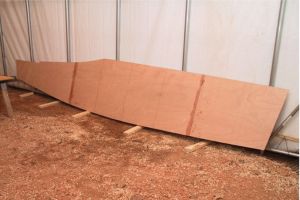 Richard has
expanded his workshop for the project, and plans to build a boat for
himself when NormsBoat is completed. Richard has
expanded his workshop for the project, and plans to build a boat for
himself when NormsBoat is completed.
Richard bought plywood and other materials and began work in late
December. Shortly after beginning, he reminded me that he works in wood,
not canvas, so I should order a sail. I had two recommendations, both of
whom you have seen advertised in "Boats".
Jim Michalak recommended Dabbler Sails in Wicomico Church, VA, about three
hours south of Washington, DC. I called him and discovered from our
conversation he was quite knowledgeable about lug sails. I faxed him a
sail plan and he sent me a quote, three sailcloth samples, a page of color
photographs, and instructions on measuring the deflection of the yard. I
was ready to send him a check but hesitated due to the 10 week delivery.
Richard Cullison recommended Douglas Fowler of Ithaca, NY. I called
him and had a similarly satisfactory conversation. I faxed him a sail plan
and he sent a quote, three sailcloth samples, and two color photos of a
Caledonia Yawl with a mainsail about the same size as NormsBoat. His price
was identical and his delivery much quicker. I sent Douglas a deposit.
 Realizing
I didn’t know much about a balanced lugsail, I went to the Michalak web
site and found an article he wrote in his
Nov. 15, 1998 newsletter on lugsails. Realizing
I didn’t know much about a balanced lugsail, I went to the Michalak web
site and found an article he wrote in his
Nov. 15, 1998 newsletter on lugsails.
By this time Richard had some plywood cut and was making bulkheads, so one
weekend John Zohlen, Ken Murphy, and I visited the boatyard. Richard has
erected a temporary shelter in front of and as an extension to his
workshop shed. The next time I visited the sides had been attached to the
stem and were spread in a “V”. I helped Richard install each bulkhead,
including two temporary ones which help hold the shape until the bottom is
on. Richard is taking digital photographs and posting them to his WWW
site:
https://www.cullisonsmallcraft.com/normsboat1page.htm
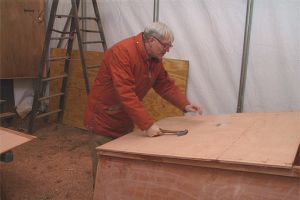 Later,
with John Zohlen’s help, we installed the bottom. I say we, because John
and I pounded at least 10 nails each, while Richard did the other 99% of
the work. Later,
with John Zohlen’s help, we installed the bottom. I say we, because John
and I pounded at least 10 nails each, while Richard did the other 99% of
the work.
Now the boat has a painted bottom and is again upright. Richard and I have
had several conversations about location of cleats, trailer eye, lazarette
cover, and lots of other details. I can see that I will have to live with
the boat for at least a year to figure out where things work best.
About a month later, it was finished, as much as a boat is ever finished.
It took Richard Cullison about 225 hours of work. I contributed about 25
hours building the rudder assembly, leeboard, sprit and yard. I spent
about $4,000 on materials, including sails, cordage, and a used trailer.
We used quality materials: okume plywood, mahogany trim, and WEST epoxy.
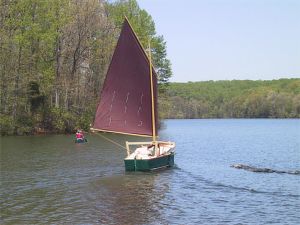 Richard
and I first wetted the bottom a week prior to the Spring Cruise at the
Tridelphia Reservoir, just North of DC on New Hampshire Ave. Fresh water,
no gas motors, but light wind the day we launched. User fee is $3.00 per
person; the boat is free. Richard
and I first wetted the bottom a week prior to the Spring Cruise at the
Tridelphia Reservoir, just North of DC on New Hampshire Ave. Fresh water,
no gas motors, but light wind the day we launched. User fee is $3.00 per
person; the boat is free.
The boat is rigged as a balanced lug, so the leading edge of the sail is
suspended forward of the mast, tensioned between the yard and the boom.
The mast is free standing, so there is no forestay. We rigged the sail and
tweaked it to find the right attachment point for the halyard on the yard,
and for the downhaul on the boom, and for the right amount of draft in the
sail. It took some doing. We did not install any lazy-jacks yet, but I can
see they would help in lowering and furling the sail.
We also mounted a temporary oar lock on the stern to try out the sculling
oar and find the right balance point and the most comfortable length. I
expected to cut off some of the 12 ½ foot length, but did not. The
seemingly long length is not hard to handle. It balances well while
sculling. It is stowed on the starboard side on the cabin top, and the
oarlock is also on the starboard side, so it is a simple matter to slide
it from the cabin top back to the stern and into the oarlock. (Any other
actions bring to mind an old cartoon with a man carrying a ladder ... you
get the idea).
We also found some adjustments needed for the trailer, trying to balance
it so about 100-150 lbs. are on the tongue. It is still a little heavy on
the tongue.
Overall, despite the light winds, the first sail was a success.
 The Shallow Water Spring Cruise, 4-6 May, was the first test in front
of witnesses. I arrived before noon and exchanged greetings with lots of
friends at the ramp. I launched without incident and, after some fussing,
I got underway and sailed to Church Creek (off the Little Choptank) in the
company of Leo Smith and Sandy Loeman in their Dovekie “Waterbed.” I
wanted to be ahead of the crowd so if I got into trouble, someone would be
following me. I was pleased to find that I could pretty much keep up with
Leo and Sandy, who are good sailors. I could “lash the tiller” (using the
Dean Meledones style bungee like I did on my Dovekie) and quickly walk
forward, adjust the sail, and return to the helm. If I did so in less than
a minute, the boat stayed pretty much on course.
The Shallow Water Spring Cruise, 4-6 May, was the first test in front
of witnesses. I arrived before noon and exchanged greetings with lots of
friends at the ramp. I launched without incident and, after some fussing,
I got underway and sailed to Church Creek (off the Little Choptank) in the
company of Leo Smith and Sandy Loeman in their Dovekie “Waterbed.” I
wanted to be ahead of the crowd so if I got into trouble, someone would be
following me. I was pleased to find that I could pretty much keep up with
Leo and Sandy, who are good sailors. I could “lash the tiller” (using the
Dean Meledones style bungee like I did on my Dovekie) and quickly walk
forward, adjust the sail, and return to the helm. If I did so in less than
a minute, the boat stayed pretty much on course.
I was pleased to see that neither the off-center mast nor just one
leeboard seemed to have any adverse effect on performance. The mast is
offset about eight inches to port, and the single leeboard is on the
starboard side. The leeboard is deeper than the Dovekie’s, so it will
adversely affect my propensity to sail in very thin water, but I will
adapt. I do miss an easy indicator to show when the leeboard has shifted
up. On the Dovekie you see the inside leeboard handle move when you touch
bottom.
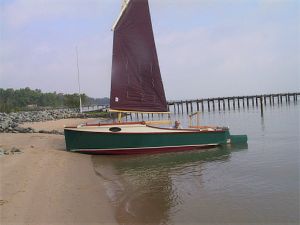 When we
entered Church Creek, we had to beat into the wind and I found I was
tacking through about 120 degrees! Not good. I knew that a standing lug
was not as good to windward as a sloop, but I hoped it would be able to
tack through the same as a Dovekie. Then I noticed that the leading edge
of the sail was a little slack. I ducked into the lee of the shore and
really hauled down on the downhaul, pulling down the boom about eight
inches and thereby tightening the leading edge. Underway again, I found
tacking much better, but my trial horse Waterbed was nearly out of sight
by then. I also realized that with the mast off-center, the close-hauled
position of the boom and sail was more over the cockpit on the starboard
tack and more away from the boat on the port tack. An hour later I lowered
sail in a dying wind and sculled to the dock at the church. The sculling
oar worked great, but I need to reduce the diameter of the oar lock stop
on the oar. It scraped the topsides under the oarlock. When we
entered Church Creek, we had to beat into the wind and I found I was
tacking through about 120 degrees! Not good. I knew that a standing lug
was not as good to windward as a sloop, but I hoped it would be able to
tack through the same as a Dovekie. Then I noticed that the leading edge
of the sail was a little slack. I ducked into the lee of the shore and
really hauled down on the downhaul, pulling down the boom about eight
inches and thereby tightening the leading edge. Underway again, I found
tacking much better, but my trial horse Waterbed was nearly out of sight
by then. I also realized that with the mast off-center, the close-hauled
position of the boom and sail was more over the cockpit on the starboard
tack and more away from the boat on the port tack. An hour later I lowered
sail in a dying wind and sculled to the dock at the church. The sculling
oar worked great, but I need to reduce the diameter of the oar lock stop
on the oar. It scraped the topsides under the oarlock.
After leaving Church Creek, the wind piped up and I tied in the first
reef, then the second. I was pleased to find the boat behaved well when
reefed. The center of effort does not change much, nor does the boom
position. I missed being able to heave to like in the Dovekie (bow c/b
down, every thing else up) to reef. (But see below).
After the raft up, I arranged my bed with my head toward the bow, which,
due to the slight rocker of the bottom, is uphill. I didn’t want to sleep
with my head downhill. In the morning, I stowed the still laid-out
mattresses and sleeping bag in two slings against the side of the boat. No
kneeling to roll them up. Great for a quick nap!
 The hatch
cover I developed from translucent white sailcloth is still in the
engineering stage. It is essentially a piece of canvas covering the 2' x
6' hatch opening, held down by bungee sewn into the sides and clipped over
four hooks on each side of the hatch combing. Four battens sprung under it
provide water-shedding camber (another Dovekie idea). So far, it only
works when the mast is stowed. Other changes from the plans include
omitting the oar ports, since I expect only to use the one sculling oar,
and erecting a Dovekie-like gallows at the aft end of the cockpit. I will
also develop a larger tent to enclose the cockpit, too, and provide
mosquito netting enclosures where appropriate. The hatch
cover I developed from translucent white sailcloth is still in the
engineering stage. It is essentially a piece of canvas covering the 2' x
6' hatch opening, held down by bungee sewn into the sides and clipped over
four hooks on each side of the hatch combing. Four battens sprung under it
provide water-shedding camber (another Dovekie idea). So far, it only
works when the mast is stowed. Other changes from the plans include
omitting the oar ports, since I expect only to use the one sculling oar,
and erecting a Dovekie-like gallows at the aft end of the cockpit. I will
also develop a larger tent to enclose the cockpit, too, and provide
mosquito netting enclosures where appropriate.
Sunday morning after breakfast I accepted a tow from John Zohlen back to
the ramp, due to the high winds and waves. I now wish I had tied in the
third reef and sailed, but then I also wanted to see how the boat behaved
being towed. I needed to stay at the helm as it did not track well, even
with the helm centered and lashed. The leeboard was up and I did not try
to lower it. This misbehavior may be in part due to the high winds and sea
state.
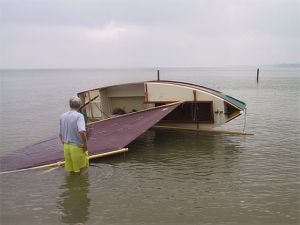 On
Memorial Day weekend I accepted the kind invitation of the John and Vera
England to the Urbana Small Boat Meet at the waterfront of Christchurch
School on the Rappahanack River. I left early Saturday morning of Memorial
Weekend in the rain, drove three hours south in the rain, and arrived in
the rain. We talked and during pauses in the rain, bailed the boat (no
cockpit drain yet) and prepared for launching. But it just rained more, so
we gave up and ate instead. The next morning the rain had stopped, so
Richard and I launched Piilu with the mast stepped but no sail, in
preparation for capsize testing. I secured the anchor in the bow well, and
added a five-gallon jug of water (about 40 lbs.) to the outboard well to
simulate stuff I would normally carry. I did not empty the lazarette of
cushions, fenders, drinking water, etc., but had no cooking or camping
stuff stowed below in the cabin. On
Memorial Day weekend I accepted the kind invitation of the John and Vera
England to the Urbana Small Boat Meet at the waterfront of Christchurch
School on the Rappahanack River. I left early Saturday morning of Memorial
Weekend in the rain, drove three hours south in the rain, and arrived in
the rain. We talked and during pauses in the rain, bailed the boat (no
cockpit drain yet) and prepared for launching. But it just rained more, so
we gave up and ate instead. The next morning the rain had stopped, so
Richard and I launched Piilu with the mast stepped but no sail, in
preparation for capsize testing. I secured the anchor in the bow well, and
added a five-gallon jug of water (about 40 lbs.) to the outboard well to
simulate stuff I would normally carry. I did not empty the lazarette of
cushions, fenders, drinking water, etc., but had no cooking or camping
stuff stowed below in the cabin.
I sat, then stood on the edge of the cabin top but my 160 lbs.could not
tip it over. Richard joined me, adding about 150 lbs. more, and it came
over easily. Water sloshed into the cockpit, but the boat floated with
about an eight-inch “draft,” not deep enough for water to enter the
lazarette or the cabin. The mast provided flotation preventing the boat
from turning turtle, with the tip of the mast about three feet below the
surface. I should mention we were standing in about four feet of calm
water, so  this was quite easy. I went around the boat and climbed up the bottom,
using the 1x4 “keel” as a step. As I grabbed the edge of the bottom
(outside chine logs) and leaned out, the boat came upright. Later tests
showed us that we could balance the boat in the water at about a 45-degree
angle.
this was quite easy. I went around the boat and climbed up the bottom,
using the 1x4 “keel” as a step. As I grabbed the edge of the bottom
(outside chine logs) and leaned out, the boat came upright. Later tests
showed us that we could balance the boat in the water at about a 45-degree
angle.
Then we raised the sails and capsized it again, first on one side, then
the other. After several tests, every thing in the cockpit was completely
drenched (I was also testing some supposedly watertight containers), and
there was about 6 inches of water at the bridge deck. It took about 10
minutes of unhurried bailing to empty. No water below nor in the lazarette,
and none in the self draining anchor well nor in the open outboard motor
well, which is wider than the anchor well. The motor well drain holes
shown on the plans have not been drilled yet.
Although the tests were made in calm water and no wind, I am comfortable
that, even in rough water the wooden mast would prevent the boat from
turning turtle. Without the mast it could turn turtle, but due to the
weight of the bottom, would be less stable than if upright.
 Later, while
sailing alone, I wanted to see what the boat would do if I lashed the helm
and let go of the sheet. To my delight, it fell off to a slow beam reach
with the sail drawing very little (no shrouds to hold the sail back). I
had discovered my “hove to” position for adjusting the sail. Now I need
jiffy reefing, because the end of the boom is too far outboard to reach
when in this position. Later, while
sailing alone, I wanted to see what the boat would do if I lashed the helm
and let go of the sheet. To my delight, it fell off to a slow beam reach
with the sail drawing very little (no shrouds to hold the sail back). I
had discovered my “hove to” position for adjusting the sail. Now I need
jiffy reefing, because the end of the boom is too far outboard to reach
when in this position.
I was also able to heel the boat comfortably, knowing that it would go to
about 45 degrees before capsizing. I doubt I was anywhere near 45 degrees,
but I had no apprehension of capsizing.
Since then I have arranged a winch and tackle to raise the boat and
trailer up into the loft of my double garage, so I can park a car
underneath. That’s another story. |